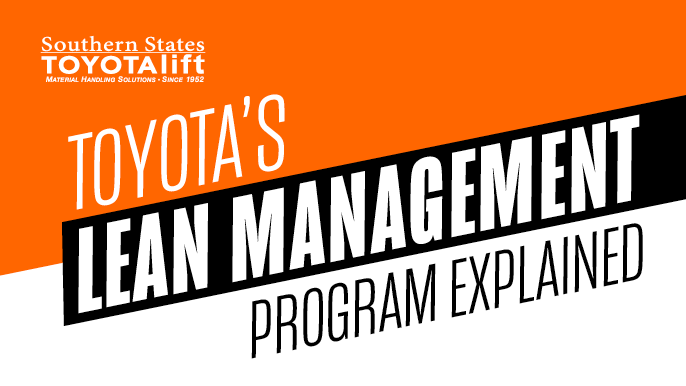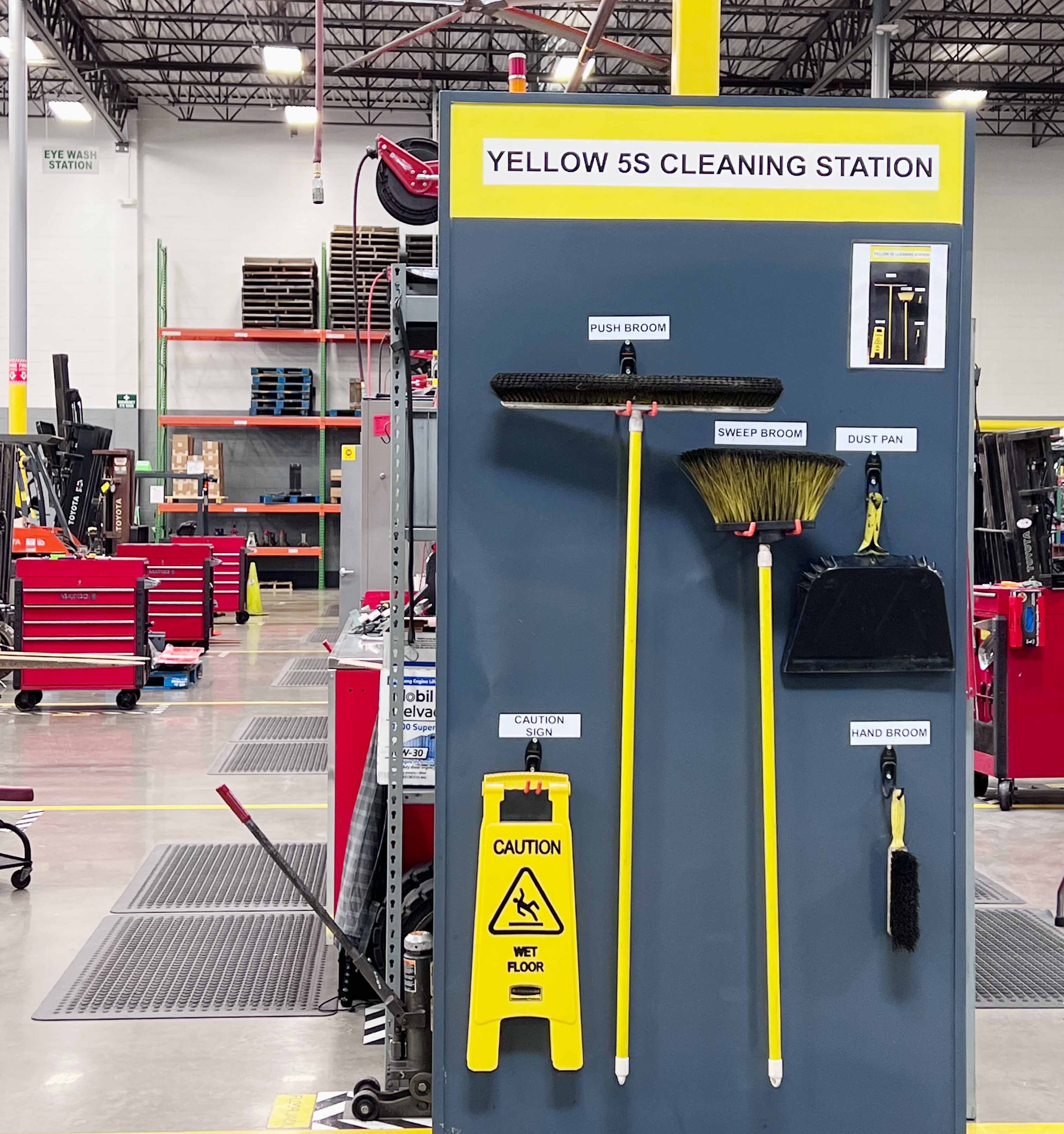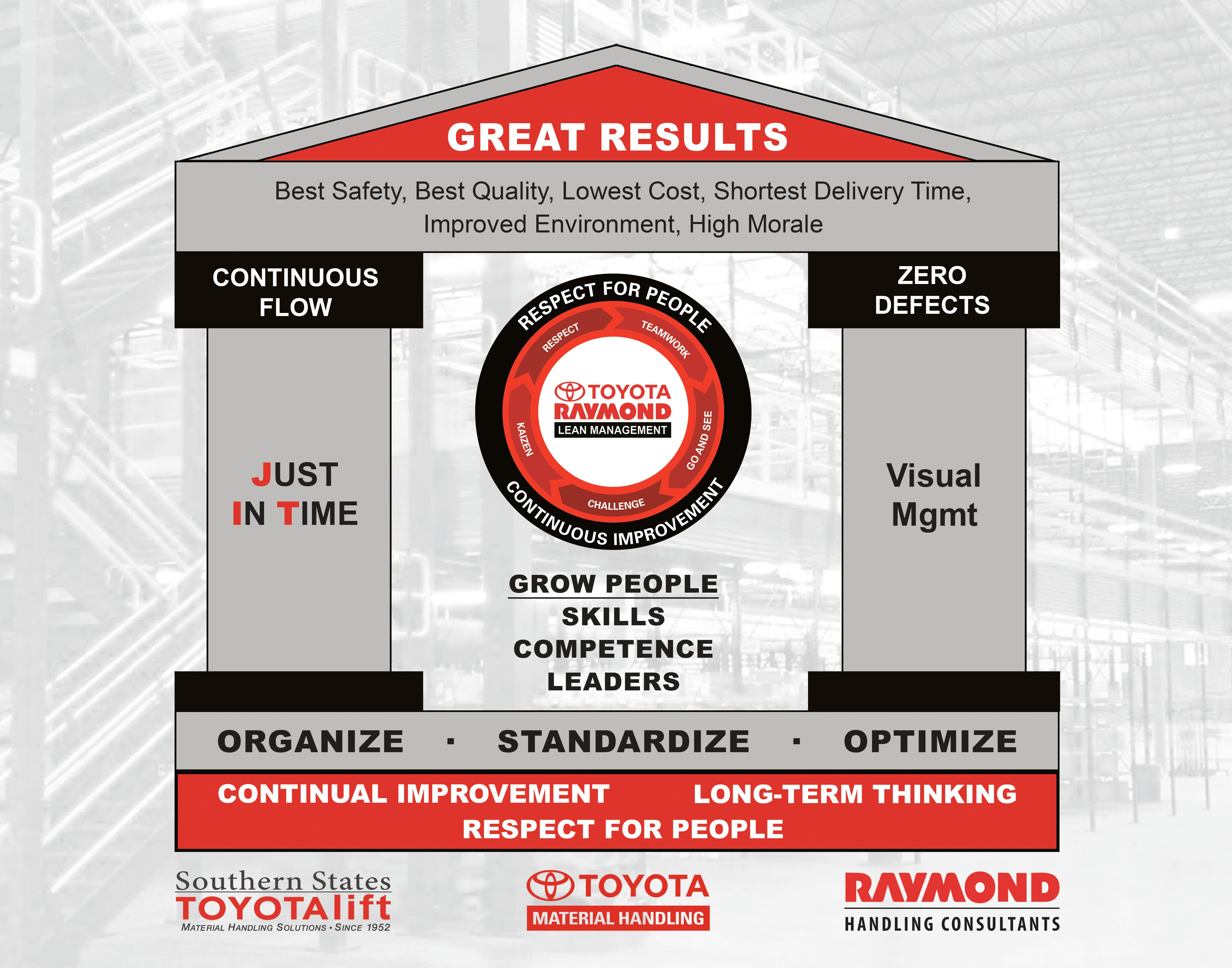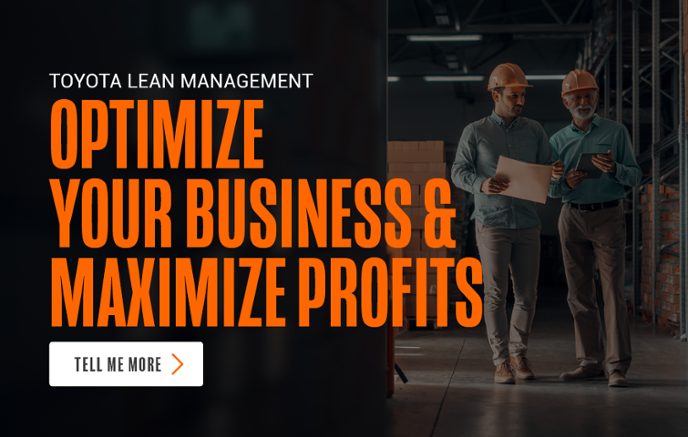Toyota’s Lean Management Program Explained (with Real Life Examples)
by Frank Stuart, on Nov 1, 2023 3:45:00 AM

If you’ve ever searched for information online about the Toyota Production System, you've probably seen a variety of house-shaped graphics. But even though we all know what a house is, understanding what the TPS house graphic means can be a challenge — especially when some of the words are Japanese.
In this article, I’ll explain the house graphic and Toyota’s lean management principles. Because I worked for Toyota and have spent many years as a Toyota lean practitioner, I’ll share insights you won’t find anywhere else including:
- How the Toyota management system boosts employee retention
- Three common misinterpretations of Toyota’s lean methodology
- Several real-world examples and a customer case study
The Toyota Production System is What Makes Toyota #1
Toyota has made the best-selling forklift in North America since 2002. That’s a long time to be number one. How do they do it? By following the Toyota Production System (TPS).
What is Toyota Lean Management vs. The Toyota Production System?
Toyota Lean Management (TLM) is a system that takes the principles of the Toyota Production System and applies them to other industries such as construction, supply chain, healthcare and of course manufacturing. I’ve yet to find a business that doesn’t benefit from the Toyota production management system.
Toyota Principles Improve Retention and Your Bottom Line
Improving efficiency and customer satisfaction are the best-known reasons for following Toyota’s lean management practices. Most people don't know it can also improve employee retention.
Hiring and retaining qualified workers was the number one challenge reported in MHI’s 2024 Top Supply Chain Challenges survey. The responses come from more than 2000 manufacturing and supply chain industry leaders from a wide range of industries.
This isn’t the first year hiring and retention created major heartburn for supply chain operations, and it likely won’t be the last. If finding and keeping good people is something your organization struggles with, TLM can help with that too.
Here’s my version of the TPS house.
Why is it a House?
Most people use a house-shaped graphic to explain TPS because the function of a house is to preserve what’s inside. All the parts of the house interact with each other to protect what’s the business and its people — from the groundwork to the pillars to the roof.
The Groundwork
Respect for People, Long-Term Thinking and Continually Improve
Respect for People, Long-Term Thinking and Continually Improve are fundamental management philosophies that drive all policy and decision-making under the Toyota way.
Respect for People is not about being nice (although that is important). This principle is about creating a home-like atmosphere where everyone is encouraged and supported to reach their full potential.
EXAMPLE: A supervisor has monthly one-on-one meetings with each associate to:
- Review personal performance
- Discuss issues with work processes
- Uncover opportunities for improvement
This mentor-mentee program develops people from within. Associates move into higher and higher positions so eventually, the people leading the company not only know the product but understand the work.
Respect for people also includes being mindful of how decisions in one department affect another. Uncoordinated decisions can negatively impact the customer.
EXAMPLE: If sales and marketing decide to have a big sale the weekend before Thanksgiving, the extra orders could overwhelm an already understaffed shipping department — creating delays for the customer and/or increased overtime expenses.
Last but not least, respect for people means providing stable employment. This leads us to the next fundamental principle…
Long-Term Thinking — During COVID and the supply chain challenges that followed, many companies made the hard decision to lay off workers. I was in the training department at Raymond during this time.
Instead of letting workers go, we chose to strengthen the company by training associates and improving processes. We developed online training programs on various topics for hundreds of associates in various roles. These actions and this type of thinking goes back to the 1950s when Toyota decided to focus on building a strong, stable company for the long term. The economy will cycle up and down, but because our people are our most important asset, we must take care of them and protect them, even during economic downturns.
Short-term decisions, like letting experienced and tenured employees go, can improve the bottom line in the short term, but long term it hurts the business. All too often, corporate culture lives and dies on a quarterly report. This is short-sighted. When times are good, you have to squirrel money away in your war chest to protect the company and its people when times are bad.
Continually Improve – It is said in business, as in life, we are either growing or dying. A structured focus on continual improvement (kaizen) and challenging the status quo ensures a company stays competitive and growing.
EXAMPLE: We challenged the team who reconditioned our forklifts this year. At the beginning of the year, our lead time was 12 weeks. By mapping the process, improving flow and using a kaizen philosophy, we are now at 6 weeks. We are not satisfied with this improvement and have further challenged the team to cut the lead time in half again by the end of this year.

The Foundation
Organize, Standardize, Optimize
The next level of the TPS house is all about creating an efficient work environment. It starts with a clean, orderly workspace where the next tool (or whatever the worker needs) is right there and not hidden in a pile of clutter.
If we don’t give people an organized workspace and standards to follow, we’re not helping them be successful. Even worse, we’re wasting their time. It goes back to respect for people.
EXAMPLE: The litmus test I used in the factory was to have a workstation set up with all the necessary tools. If I could take a tool away from the workstation and the operator couldn’t tell me within five seconds what was missing, that meant we had more work to do to.
To be clear, it isn’t about telling people: you must do it this way or to make changes for the sake of making changes. The goal is to:
- Find the best way of doing things for the people who are doing the work
- Develop standards and best practices
- If a better way is found, everyone starts using that new way instead
That last bullet point is the principle of kaizen showing up again. Toyota Lean Management is an ongoing process where small, incremental changes result in measurable improvements to quality or reduced cost, cycle or delivery times.
FYI, we haven’t gotten to the actual Toyota Production System yet. The groundwork and the foundation are the basis for TPS. The system doesn’t work without establishing the groundwork and creating a solid foundation.
Creating optimized workspaces and processes are deceptively simple assignments. It’s really easy to make work hard and it’s hard to make work easy. When you’re stuck in chaos it can be hard to see the way out.
The foundation of TPS helps make work easy. Once an orderly, efficient system has been established, we work on the two pillars.
TPS Pillars: The Toyota Production System
Pillar One
Just in Time & Continuous Flow
The first pillar is all about having what you need, when you need it. Waste, in the form of wasted time or excess inventory, should be avoided.
Back in 2021, Bloomberg and other news organizations excitedly reported how Toyota had abandoned its “just in time” philosophy because it started stockpiling computer chips. This is just one example of how Toyota principles are misunderstood by the Western world.
Misunderstanding #1
Here’s what most news outlets got wrong: After the earthquake and tsunami in 2011, Toyota reevaluated the lead time required for semiconductors and other parts. Their assessment revealed they were unprepared for a major shock to the supply chain, such a natural disaster.
To ensure a continuous flow of chips to their factories, Toyota required suppliers to carry a 2-6 month supply of semiconductors. When COVID hit, the news reported Toyota was “stockpiling” chips when, in fact, the company was simply following a plan it had created ten years earlier.

Our business training in the Western world is all about the balance sheet. Reducing inventory becomes a goal unto itself and that’s when things start to go badly. “Just in time” doesn’t mean “last minute.” It means keeping enough supply to ensure a continuous flow.
For Toyota, "just in time" meant a supply that could weather supply chain ups and downs. In 2021, when the chip shortage forced other automakers to stop their production lines, Toyota kept churning out vehicles and raised its earnings forecast by 54%.
Pillar Two
Visual Management & Zero Defects
EXAMPLE: Zero defects is pretty self-explanatory, but here’s an example of zero defects through visual management. The first thing Mr. Toyoda built was an automated loom for the textile industry. Occasionally, a thread would break and the operator wouldn’t see it. When this happened, the final product had to be thrown away.
To fix the problem, Mr. Toyoda put a washer in the thread. If the thread broke, the washer fell off into the machine and it stopped. The operator could fix the problem without any waste (defective product). This also allowed one operator to oversee multiple machines.
Misunderstanding #2
Some people say Toyota Lean Management is basically the same as Six Sigma. I disagree. There are major differences between the two systems, but here’s a big one related to TPS Pillar Two: Six Sigma says you can have 3.4 defects per million operations. An “operation” is defined as a single action, such as attaching a wire or screwing a bolt. Building a jumbo jet requires millions of operations. Knowing 3.4 defects are permitted per million operations, would you rather fly on an airplane built by a company that follows Six Sigma principles or Toyota?
Another comparison you may have heard is one about a GM versus a Toyota factory. At GM, workers can get in trouble for stopping the line. At Toyota, it’s the opposite. If workers aren’t periodically stopping the line, managers get concerned. It goes back to the fundamental principles we talked about in the very beginning: respect for people and a culture of continuous improvement.
Toyota Lean Management Case Study
I worked with a hard cider manufacturer in upstate NY. The company was approaching its busy season and trying to build up its inventory to supply its distributor. Their “we gotta get this done” mentality caused them to overrun their facility.
A Foundational Problem
The company thought they were following the “just in time” lean methodology. What they had was a mess.
- Product and supplies were all over the place
- Equipment was haphazardly maintained
- They didn't have good standards on how to clean the kegs
A bottleneck in their system meant a new batch would get stuck behind the previous batch and unfinished inventory would pile up. Disorganization and stress led to unnecessary handling, damage and waste (wasted time and wasted product).
After speaking to everyone who helped produce the cider, we created a list of best practices. Next, we helped the company organize, standardize and optimize the workspaces and procedures throughout their facility. With groundwork laid and a firm foundation in place, we were ready to move on to Pillars One and Two.

Guess what? The company had more than enough capacity. They didn’t need to build up inventory for their distributor. All they had to do was tame their operational chaos.
- Standardized practices saved time and improved product quality
- Clear processes and optimized workspaces helped everyone work more efficiently
- The company reclaimed space previously used to store inventory
Cider Batches Now Flow Continuously
Once the bottleneck was subdued and equipment was kept in good working order, the cider company could run continuously with minimal downtime between batches. By staggering five batches to start over six weeks the company could meet customer demands.
The Core of the House: Its People
Grow People: Skills, Competence, Leaders
I added this circle in the center of the house (you won’t find it in other TPS house graphics) because I was fortunate to learn about Toyota’s lean management system directly from Toyota executives.
The addition was inspired by a story I heard that really stuck in my mind. Mr. Onishi, Toyota’s president, visited a plant in Canada. He asked one of the plant managers to explain TPS. The manager described the house and the elements of zero defects, continuous improvement, etc. Mr. Onishi politely said, “It’s actually a people development process. We want to improve people’s skills and competence and grow them into leaders. Our goal is to promote people from within because they know the products, the customers and understand the work.”
The TPS Circle
Everything starts and ends with respect.
Teamwork is about supporting the person who does the thing the customer is paying for.
EXAMPLE: At SST, that means the technician working on a customer’s forklift.
Go and See — when a problem arises, the best way to find a solution is to observe the problem.
EXAMPLE #1: At the forklift factory, units occasionally came off the line with the wrong counterweight. We observed the employee do everything right until one time he read the build sheet but chose the wrong counterweight. He was always on the go which created an opportunity for this mistake. By adding a simple step, stopping to highlight the weight info, the problem disappeared.

EXAMPLE #2: A warehouse thought they needed to buy more pallet rack and even had a rack consultant on-site while I was there. Turns out the company had plenty of rack space. They just needed to throw out three years of inventory they couldn't sell. The executive team almost wasted thousands of dollars on rack they didn’t need rather than take a hit on their balance sheet.
Challenge does not mean I had a challenging day because two associates didn’t show up for work. It means aiming for the stars and making it to the moon.
To generate significant improvements, you need an aggressive challenge and a team that’s committed to reaching a common goal. It changes your approach. To keep the space analogy going, consider all the technological innovations we enjoy that came from putting a man on the moon.
Misunderstanding #3
Toyota’s Production System strives for 100% customer satisfaction by eliminating wasteful activities. Many business leaders incorrectly believe running lean means using cheaper materials or reducing staff. By now you know this isn't the Toyota way. Building a strong house requires leaders who respect their people and think long-term.
Companies that refuse to think beyond the bottom line will always struggle to stay competitive. Their short-term savings on cheap materials create long-term losses as customers become dissatisfied. They will also waste money hiring and training people who leave when they aren’t treated with respect.
Sometimes I have to have a conversation with new clients about helping team members overcome challenges. When something goes wrong, some companies look for someone to blame (reprimand or fire) but that’s not the Toyota way.
Toyota’s approach focuses on fixing broken systems, not pointing fingers. We encourage leaders to challenge their team members to improve processes, but if the team member fails and gets fired after one try, how is that person’s replacement going to feel about taking on the same challenge?
The Roof of the TPS House
The roof protects the house and the people inside. A safe workplace that produces quality products at the lowest cost with the shortest delivery time in a good environment generates high morale and protects the business. By protecting the business, you protect the people inside and help them to grow into successful leaders.
Request a Free Toyota Lean Management Consultation
If you’d like to reduce costs and turnover while increasing customer satisfaction, why not schedule a free consultation? Toyota Lean Management has a low cost of implementation and is designed to help you get more out of your existing resources.
During the initial consultation, we’ll talk about where your company is now versus where you’d like to be. The next steps depend on the individual client, but typically we’ll Go and See your space and look for:
- Inventory build-ups
- Excessive transportation
- Cluttered workspaces
- Unnecessary motion
- Producing more than what’s needed for the near-term
- Piles of defects
To learn more, contact us online or by phone (800) 226-2345.
FLORIDA: Jacksonville South, Jacksonville North, Ocala, Orlando, Lakeland, Tampa, Winter Haven
GEORGIA: Albany, Macon, Midland, Valdosta










